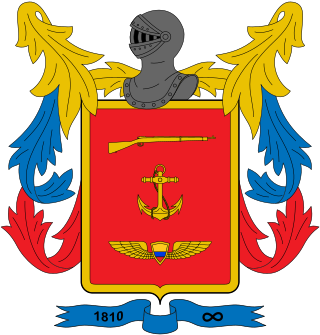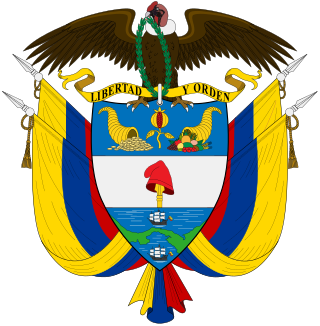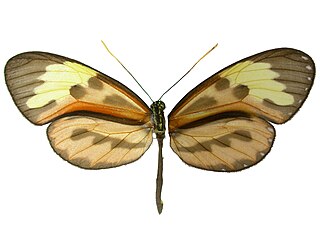
Colombia, officially the Republic of Colombia, is a country primarily located in South America with insular regions in North America. The Colombian mainland is bordered by the Caribbean Sea to the north, Venezuela to the east and northeast, Brazil to the southeast, Ecuador and Peru to the south and southwest, the Pacific Ocean to the west, and Panama to the northwest. Colombia is divided into 32 departments. The Capital District of Bogotá is also the country's largest city hosting the main financial and cultural hub. Other major urbes include Medellín, Cali, Barranquilla, Cartagena, Santa Marta, Cúcuta, Ibagué, Villavicencio and Bucaramanga. It covers an area of 1,141,748 square kilometers and has a population of around 52 million. Its rich cultural heritage—including language, religion, cuisine, and art—reflects its history as a colony, fusing cultural elements brought by immigration from Europe and the Middle East, with those brought by the African diaspora, as well as with those of the various Indigenous civilizations that predate colonization. Spanish is the official language, although Creole, English and 64 other languages are recognized regionally.
The politics of Colombia take place in a framework of a presidential representative democratic republic, whereby the President of Colombia is both head of state and head of government, and of a multi-party system. Executive power is carried out by the government. Legislative power is vested in both the government and the two chambers of congress, the Senate and the House of Representatives of Colombia. The Judiciary is independent of the executive and the legislature.

The Military Forces of Colombia are the unified armed forces of the Republic of Colombia. They consist of the Colombian Army, the Colombian Navy and the Colombian Aerospace Force. The National Police of Colombia, although technically not part of the military, is controlled and administered by the Ministry of National Defence, and national conscription also includes service in the National Police, thus making it a de facto gendarmerie and a branch of the military. The President of Colombia is the military's commander in chief, and helps formulate defense policy through the Ministry of National Defence, which is in charge of day-to-day operations.

Bogotá, officially Bogotá, Distrito Capital, abbreviated Bogotá, D.C., and formerly known as Santa Fe de Bogotá during the Spanish Colonial period and between 1991 and 2000, is the capital and largest city of Colombia, and one of the largest cities in the world. The city is administered as the Capital District, as well as the capital of, though not politically part of, the surrounding department of Cundinamarca. Bogotá is a territorial entity of the first order, with the same administrative status as the departments of Colombia. It is the main political, economic, administrative, industrial, cultural, airport, technological, scientific, healthcare and educational center of the country and northern South America.

The illegal drug trade, drug trafficking, or narcotrafficking is a global black market dedicated to the cultivation, manufacture, distribution and sale of prohibited drugs. Most jurisdictions prohibit trade, except under license, of many types of drugs through the use of drug prohibition laws. The think tank Global Financial Integrity's Transnational Crime and the Developing World report estimates the size of the global illicit drug market between US$426 and US$652 billion in 2014 alone. With a world GDP of US$78 trillion in the same year, the illegal drug trade may be estimated as nearly 1% of total global trade. Consumption of illegal drugs is widespread globally, and it remains very difficult for local authorities to reduce the rates of drug consumption.

Bolívar is a department of Colombia. It was named after one of the original nine states of the United States of Colombia. It is located to the north of the country, extending roughly north–south from the Caribbean coast at Cartagena near the mouth of the Magdalena River, then south along the river to a border with Antioquia Department. The departments of Sucre and Córdoba are located to the west, and Atlántico Department to the north and east. Across the Magdalena River to the east is Magdalena Department. The flag of the department bears a resemblance to the flag of Lithuania.

The coat of arms of Colombia contains a shield with numerous symbols. Perched on top of the shield is an Andean condor holding an olive crown and the condor symbolizing freedom. The national motto, Libertad y Orden, is on a scroll in between the bird and the shield in black font over golden background. The condor is depicted as displayed and looking to the right.

Caldas is a department of Colombia named after Colombian patriotic figure Francisco José de Caldas. It is part of the Paisa Region and its capital is Manizales. The population of Caldas is 998,255, and its area is 7,291 km2. Caldas is also part of the Colombian Coffee-Growers Axis region along with the Risaralda and Quindio departments, which were politically separated from Caldas in 1966.

The Colombian Football Federation is the governing body of association football in Colombia. The organization was founded in 1924 and has been affiliated with FIFA since 1936. It is a member of CONMEBOL and in charge of the Colombia national football team and the Colombia women's national football team.

Around 99.2% of Colombians speak the Spanish language. 65 Amerindian languages, 2 Creole languages, the Portuguese language and the Romani language are also spoken in the country. English has official status in the San Andrés, Providencia and Santa Catalina Islands.

The semiplumbeous hawk is a species of bird of prey in the family Accipitridae. It is found in Colombia, Costa Rica, Ecuador, Honduras, and Panama. Its natural habitat is subtropical or tropical moist lowland forests.

The Colombia women's national football team represents Colombia in international women's football competitions and is controlled by the Colombian Football Federation. They are a member of the CONMEBOL. The team is currently ranked 28th in the FIFA Ranking and has qualified for three FIFA Women's World Cups, in Germany 2011, Canada 2015 and Australia–New Zealand 2023.

Colombia made its Paralympic Games début at the 1976 Summer Paralympics in Toronto, with competitors taking part in track and field, table tennis and wheelchair basketball. The country has participated in every subsequent edition of the Summer Paralympics, except 1984, but has never entered the Winter Paralympics.

Ceratinia is a genus of clearwing (ithomiine) butterflies, named by Jacob Hübner in 1816. They are in the brush-footed butterfly family, Nymphalidae.

Ceratinia tutia, the tutia clearwing, is a species of butterfly of the family Nymphalidae. It is found from southern Mexico to Brazil. The wingspan is about 52 mm. It is a highly variable species. The larvae of subspecies Ceratinia tutia dorilla have been recorded feeding on Solanum species, including S. antillarum.

Ceratinia neso, the Neso tigerwing, is a species of butterfly of the family Nymphalidae. It is found in South America.
Ceratinia cayana is a species of butterfly of the family Nymphalidae. It is found in Brazil, Suriname and the Guianas.
Agaritha iolaia is a species of beetle in the family Cerambycidae, and the only species in the genus Agaritha. It was described by Dillon and Dillon in 1945.












